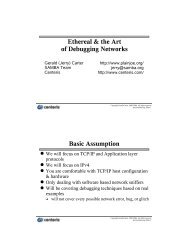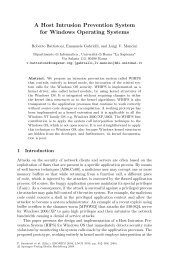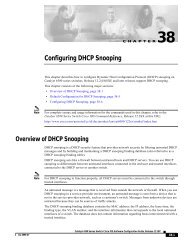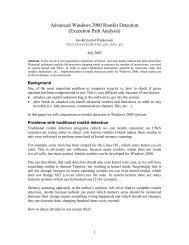Real-Time Intrusion Detection with Emphasis on Insider Attacks
Real-Time Intrusion Detection with Emphasis on Insider Attacks
Real-Time Intrusion Detection with Emphasis on Insider Attacks
Create successful ePaper yourself
Turn your PDF publications into a flip-book with our unique Google optimized e-Paper software.
<str<strong>on</strong>g>Real</str<strong>on</strong>g>-<str<strong>on</strong>g>Time</str<strong>on</strong>g> <str<strong>on</strong>g>Intrusi<strong>on</strong></str<strong>on</strong>g> <str<strong>on</strong>g>Detecti<strong>on</strong></str<strong>on</strong>g><br />
<str<strong>on</strong>g>with</str<strong>on</strong>g> <str<strong>on</strong>g>Emphasis</str<strong>on</strong>g> <strong>on</strong> <strong>Insider</strong> <strong>Attacks</strong><br />
Shambhu Upadhyaya<br />
University at Buffalo, Buffalo, New York, 14260, USA<br />
shambhu@cse.Buffalo.EDU<br />
1 Introducti<strong>on</strong><br />
Securing the cyberspace from attacks is critical to the ec<strong>on</strong>omy and well being of any<br />
country. During the past few years, threats to cyberspace have risen dramatically. It is<br />
impossible to close all security loopholes in a computer system by building firewalls<br />
or using cryptographic techniques. As a result, intrusi<strong>on</strong> detecti<strong>on</strong> has emerged as a<br />
key technique for cyber security. Currently there are more than 100 commercial tools<br />
and research prototypes for intrusi<strong>on</strong> detecti<strong>on</strong>. These can be largely classified as<br />
either misuse or anomaly detecti<strong>on</strong> systems. While misuse detecti<strong>on</strong> looks for specific<br />
signs by comparing the current activity against a database of known activity, anomaly<br />
detecti<strong>on</strong> works by generating a reference line based <strong>on</strong> the system model and signaling<br />
significant deviati<strong>on</strong>s from it as intrusi<strong>on</strong>s. Both approaches rely <strong>on</strong> audit trails,<br />
which can be very huge. Moreover, c<strong>on</strong>venti<strong>on</strong>ally they are off-line and offer little in<br />
terms of str<strong>on</strong>g deterrence in the face of attacks.<br />
In this talk, we will examine the intrusi<strong>on</strong> detecti<strong>on</strong> tools and techniques from a<br />
tax<strong>on</strong>omical point of view and study the real-time properties and applicability to real<br />
systems and their shortcomings. Following the overview, we will present our own<br />
cost analysis-based framework, which quantifies and handles both misuse and anomalies<br />
in a unified way. Decisi<strong>on</strong>s regarding intrusi<strong>on</strong>s are seldom binary and we have<br />
developed a reas<strong>on</strong>ing framework that makes decisi<strong>on</strong>s <strong>on</strong> a more informed basis. The<br />
overall reference graph is based <strong>on</strong> the user’s profile and the intent obtained at the<br />
beginning of sessi<strong>on</strong>s. The uniqueness of each user’s activity helps identify and arrest<br />
attempts by intruders to masquerade as genuine users, which is typically the case in<br />
insider attacks. We will examine this work and present some results.<br />
2 Brief History<br />
The goal of intrusi<strong>on</strong> detecti<strong>on</strong> system (IDS) is to m<strong>on</strong>itor network assets to detect<br />
misuse or anomalous behavior. Research <strong>on</strong> intrusi<strong>on</strong> detecti<strong>on</strong> started in 1980 as a<br />
government project and under the leadership of Dorothy Denning at SRI Internati<strong>on</strong>al,<br />
the first model for intrusi<strong>on</strong> detecti<strong>on</strong> was developed in 1983 [3]. Earlier versi<strong>on</strong>s<br />
of intrusi<strong>on</strong> detecti<strong>on</strong> systems were largely host-based and the work of the<br />
“Haystack project” led to network level intrusi<strong>on</strong> detecti<strong>on</strong> systems. Commercial<br />
intrusi<strong>on</strong> detecti<strong>on</strong> systems were introduced in the 90’s and today there are more than<br />
100 tools and prototypes that can be purchased or experimented <str<strong>on</strong>g>with</str<strong>on</strong>g>. Most of these<br />
tools work <strong>on</strong> audit trail data or data packets obtained across the network.<br />
V. Gorodetsky et al. (Eds.): MMM-ACNS 2003, LNCS 2776, pp. 82–85, 2003.<br />
© Springer-Verlag Berlin Heidelberg 2003
<str<strong>on</strong>g>Real</str<strong>on</strong>g>-<str<strong>on</strong>g>Time</str<strong>on</strong>g> <str<strong>on</strong>g>Intrusi<strong>on</strong></str<strong>on</strong>g> <str<strong>on</strong>g>Detecti<strong>on</strong></str<strong>on</strong>g> <str<strong>on</strong>g>with</str<strong>on</strong>g> <str<strong>on</strong>g>Emphasis</str<strong>on</strong>g> <strong>on</strong> <strong>Insider</strong> <strong>Attacks</strong> 83<br />
First generati<strong>on</strong> intrusi<strong>on</strong> detecti<strong>on</strong> tools are essentially misuse signature-based and<br />
security is accomplished by iterative “penetrate and patch”. Today’s focus is <strong>on</strong> detecting<br />
novel intrusi<strong>on</strong>s. With the proliferati<strong>on</strong> of the Internet and the increased power<br />
of the attacker, short term soluti<strong>on</strong>s and tools not very useful and new soluti<strong>on</strong>s must<br />
c<strong>on</strong>sider insider attacks, social engineering based break-ins and the myriad ways of<br />
perpetrating an attack. Some of the new ideas include combining intrusi<strong>on</strong> detecti<strong>on</strong><br />
<str<strong>on</strong>g>with</str<strong>on</strong>g> vulnerability analysis and c<strong>on</strong>sidering recovery al<strong>on</strong>g <str<strong>on</strong>g>with</str<strong>on</strong>g> detecti<strong>on</strong> since detecti<strong>on</strong><br />
is not fool proof.<br />
3 <str<strong>on</strong>g>Intrusi<strong>on</strong></str<strong>on</strong>g> <str<strong>on</strong>g>Detecti<strong>on</strong></str<strong>on</strong>g> Tax<strong>on</strong>omy<br />
Debar, Dacier and Wespi gave the first tax<strong>on</strong>omy of intrusi<strong>on</strong> detecti<strong>on</strong> systems [2].<br />
They used <str<strong>on</strong>g>Detecti<strong>on</strong></str<strong>on</strong>g> Method, Behavior <strong>on</strong> <str<strong>on</strong>g>Detecti<strong>on</strong></str<strong>on</strong>g>, Audit Source Locati<strong>on</strong>, <str<strong>on</strong>g>Detecti<strong>on</strong></str<strong>on</strong>g><br />
Paradigm and User Frequency as the parameters of classificati<strong>on</strong>. Upadhyaya and<br />
Kwiat introduced a variati<strong>on</strong> of the tax<strong>on</strong>omy and presented it in a tutorial in IEEE<br />
MILCOM 2002. According to this tax<strong>on</strong>omy, intrusi<strong>on</strong> detecti<strong>on</strong> techniques and tools<br />
are classified al<strong>on</strong>g four major parameters as follows: (1) <str<strong>on</strong>g>Detecti<strong>on</strong></str<strong>on</strong>g> Methodology —<br />
this classificati<strong>on</strong> uses informati<strong>on</strong> about attacks versus informati<strong>on</strong> about normal<br />
functi<strong>on</strong>ing of the system; (2) Scope — host based versus network based systems; (3)<br />
M<strong>on</strong>itor Philosophy — passive versus proactive; and (4) M<strong>on</strong>itor level — kernel level<br />
versus user operati<strong>on</strong> level. <str<strong>on</strong>g>Detecti<strong>on</strong></str<strong>on</strong>g> methodology also depends <strong>on</strong> the reas<strong>on</strong>ing<br />
philosophy. For example, rule-based versus model-based. Host based IDS tools work<br />
<strong>on</strong> the host, can detect masquerade, account break-in etc. whereas Network based<br />
tools are applicable to large-scale networks and depend <strong>on</strong> informati<strong>on</strong> <strong>on</strong> network<br />
packets. Passive tools are n<strong>on</strong>invasive, n<strong>on</strong>-intrusive but mostly are after-the-fact and<br />
use no communicati<strong>on</strong> <str<strong>on</strong>g>with</str<strong>on</strong>g> users whereas Proactive schemes are real-time, c<strong>on</strong>current<br />
detecti<strong>on</strong> tools <str<strong>on</strong>g>with</str<strong>on</strong>g> low latency and employ user interrogati<strong>on</strong> where needed.<br />
Finally, the Kernel level tools make use of low level informati<strong>on</strong> and process data to<br />
synthesize the attack scenarios whereas User operati<strong>on</strong> level tools can capture user<br />
semantics and are capable of detecting subtle intrusi<strong>on</strong>s.<br />
4 <strong>Insider</strong> <strong>Attacks</strong><br />
An insider threat is <strong>on</strong>e in which some<strong>on</strong>e <str<strong>on</strong>g>with</str<strong>on</strong>g> an authorized access to the organizati<strong>on</strong><br />
could cause a loss to the organizati<strong>on</strong> if computer security went unchecked. The<br />
perpetrators are those who work for the target organizati<strong>on</strong> or those having relati<strong>on</strong>ships<br />
<str<strong>on</strong>g>with</str<strong>on</strong>g> the firm <str<strong>on</strong>g>with</str<strong>on</strong>g> some level of access. It could be employees, c<strong>on</strong>tractors,<br />
business partners, customers etc. The motives could range from financial, social,<br />
political to pers<strong>on</strong>al gains. There are two classes of insiders — logical insiders who<br />
are physically outside and physical insiders who are logically outside. The misuse<br />
could be intenti<strong>on</strong>al or accidental, obvious or hidden. Here are a few insider attacks<br />
that made headlines.<br />
• An individual faces federal criminal charges in US District Court in Miami for<br />
allegedly downloading a virus into his employer’s computer system, crashing the<br />
network for nearly two full days (NIPC Daily Report, Aug. 29, 2001).
84 S. Upadhyaya<br />
• Former programmer Timothy Lloyd, who was fired in 1996, retaliated by setting<br />
off a logic bomb that destroyed employer Omega Engineering’s primary database,<br />
causing $12 milli<strong>on</strong> damage and forcing 80 people to be laid off (Security Wire<br />
Digest, Vol. 3, No. 12, Feb. 12, 2001).<br />
• Feds charge 3 in massive credit fraud scheme. Initial losses estimated at $2.7 milli<strong>on</strong><br />
(CNN.com, 2002).<br />
CSI/FBI 1999 Computer Crime Survey indicated that 55% of the reported attacks<br />
were from insiders. CSI/FBI 2000 Computer Crime Survey stated that 71% of the<br />
resp<strong>on</strong>dents had been the victim of internal attacks. Dealing <str<strong>on</strong>g>with</str<strong>on</strong>g> this problem involves<br />
three steps: modeling the insider, preventi<strong>on</strong> of internal misuse and detecti<strong>on</strong>,<br />
and analysis and identificati<strong>on</strong> of misuse. Approaches to preventi<strong>on</strong> are to install and<br />
execute appropriate anti-virus tools, install software updates and patches, encrypt<br />
databases, key system files and even executables, electr<strong>on</strong>ically “watermark” documents<br />
so that their passage through any electr<strong>on</strong>ic gate can be automatically detected<br />
and prevented and isolate privileged executi<strong>on</strong> domain from less privileged executi<strong>on</strong><br />
domains and implement multilevel security policies.<br />
5 Surveillance Issues<br />
The questi<strong>on</strong>s that need to be addressed to mitigate insider attacks are: what kind of<br />
model <strong>on</strong>e should develop, should we c<strong>on</strong>sider preventi<strong>on</strong> or detecti<strong>on</strong> or both,<br />
should the method be passive or proactive For optimizing detecti<strong>on</strong>, the technology<br />
must be tamper-resistant, must not burden the m<strong>on</strong>itoring system and must be costeffective.<br />
In this talk, we c<strong>on</strong>sider just the detecti<strong>on</strong> problem. The insider attack detecti<strong>on</strong><br />
approaches are generally anomaly-based and could range from rule-based<br />
detecti<strong>on</strong>, to statistical anomaly detecti<strong>on</strong> and proactive schemes such as query-based<br />
encapsulati<strong>on</strong> of owner intent [4].<br />
6 A New Proactive Scheme for <strong>Insider</strong> Threat <str<strong>on</strong>g>Detecti<strong>on</strong></str<strong>on</strong>g><br />
Our approach relies <strong>on</strong> user level anomaly detecti<strong>on</strong> that avoids after-the-fact soluti<strong>on</strong>s<br />
such as audit data analysis. We leverage ideas from fault tolerance where c<strong>on</strong>current<br />
m<strong>on</strong>itoring is used to detect c<strong>on</strong>trol-flow errors. We capture owner’s intent<br />
and use it as a reference signature for m<strong>on</strong>itoring and a reas<strong>on</strong>ing framework is developed<br />
for making rati<strong>on</strong>al decisi<strong>on</strong>s about intrusi<strong>on</strong>s. Certain engineering methodologies<br />
such as Divide and C<strong>on</strong>quer are used to address scalability of the approach.<br />
We obtain the reference graph by Encapsulati<strong>on</strong> of owner’s intent, which requires<br />
an implicit or explicit query of users for a sessi<strong>on</strong>-scope. We then translate it into a set<br />
of verifiable asserti<strong>on</strong>s. Actual operati<strong>on</strong>s are m<strong>on</strong>itored at user command level and<br />
the user behavior is assessed. The advantages of this approach are: no need to process<br />
huge audit data and both external/internal abuse can be handled uniformly [4]. Reas<strong>on</strong>ing<br />
about intrusi<strong>on</strong>s is d<strong>on</strong>e by a stochastic modeling of job activity. A doublethreshold<br />
scheme is used to resolve situati<strong>on</strong>s arising when job activity cost maps into<br />
an ambiguous regi<strong>on</strong>. Cost gradients are used to shrink the window of uncertainty so<br />
that a speedy decisi<strong>on</strong> <strong>on</strong> intrusi<strong>on</strong> can be arrived [5]. Anomaly detectors are always
<str<strong>on</strong>g>Real</str<strong>on</strong>g>-<str<strong>on</strong>g>Time</str<strong>on</strong>g> <str<strong>on</strong>g>Intrusi<strong>on</strong></str<strong>on</strong>g> <str<strong>on</strong>g>Detecti<strong>on</strong></str<strong>on</strong>g> <str<strong>on</strong>g>with</str<strong>on</strong>g> <str<strong>on</strong>g>Emphasis</str<strong>on</strong>g> <strong>on</strong> <strong>Insider</strong> <strong>Attacks</strong> 85<br />
faced <str<strong>on</strong>g>with</str<strong>on</strong>g> the scalability problem due to the large number of partial orderings of<br />
operati<strong>on</strong>s. While no improvements over worst-case complexity exist, we employ<br />
engineering approaches such as divide and c<strong>on</strong>quer and use the c<strong>on</strong>cept of job priorities,<br />
user workspaces and meta-operati<strong>on</strong>s for m<strong>on</strong>itoring [1]. We are currently building<br />
a prototype of the system to dem<strong>on</strong>strate the proof-of-c<strong>on</strong>cept.<br />
References<br />
1. Chinchani, R., Upadhyaya, S., and Kwiat, K.: Towards the scalable implementati<strong>on</strong> of a<br />
user level anomaly detecti<strong>on</strong> system. IEEE MILCOM 2002, Anaheim, CA (October 2002)<br />
2. Debar, H., Dacier, M., and Wespi, A.: Towards a Tax<strong>on</strong>omy of <str<strong>on</strong>g>Intrusi<strong>on</strong></str<strong>on</strong>g> <str<strong>on</strong>g>Detecti<strong>on</strong></str<strong>on</strong>g> Systems.<br />
Computer Networks, 31 (1999) 805–822<br />
3. Dening, D.: An <str<strong>on</strong>g>Intrusi<strong>on</strong></str<strong>on</strong>g>-<str<strong>on</strong>g>Detecti<strong>on</strong></str<strong>on</strong>g> Model. IEEE Transacti<strong>on</strong>s <strong>on</strong> Software Engineering,<br />
Vol. SE-13, No. 2 (February 1987) 222–232<br />
4. Upadhyaya, S. and Kwiat, K.: A distributed c<strong>on</strong>current intrusi<strong>on</strong> detecti<strong>on</strong> scheme based <strong>on</strong><br />
asserti<strong>on</strong>s. SCS Int. Symposium <strong>on</strong> Performance Evaluati<strong>on</strong> of Computer and Telecommunicati<strong>on</strong><br />
Systems, Chicago, IL (July 1999) 369–376<br />
5. Upadhyaya S., Chinchani, R., and Kwiat, K.: An analytical framework for reas<strong>on</strong>ing about<br />
intrusi<strong>on</strong>s. IEEE Symposium <strong>on</strong> Reliable Distributed Systems, New Orleans, LA (October<br />
2001) 99–108









